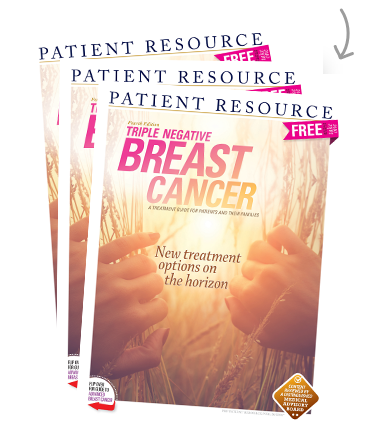Triple Negative Breast Cancer
Many people are familiar with breast cancer, but fewer know about triple negative breast cancer (TNBC), a subtype with distinct characteristics. TNBC tends to be more aggressive (fast growing) and may recur (come back) within a few years after initial diagnosis. Women with this subtype may now have a new treatment option — immunotherapy. The first immunotherapy for any type of breast cancer was approved in 2019 specifically for TNBC, marking a significant advancement and offering new hope.
TNBC is more prevalent in young women, African American women and BRCA1 mutation carriers. Though a TNBC diagnosis can be unsettling because of its nature, one of the most important things you can do is to educate yourself about this disease and how to treat it.
Breast cancer starts from one abnormal cell that grows out of control and forms a mass of abnormal cells called a tumor. Some breast cancers need hormones to grow. The cancer cells in these breast cancers contain large amounts of receptors for the hormones estrogen and/or progesterone. These breast cancers are referred to as ER-positive (ER+) and/or PRpositive (PR+).
In addition, a breast cancer cell can have too many receptors for a certain protein called HER2-neu, which is a growth factor. This type of a breast cancer is referred to as HER2- positive (HER2+). The discovery of these differences led to the development of targeted treatments for these specific breast cancers. For example, hormone therapy is used for ER+ and/ or PR+ breast cancers, and anti-HER2 drugs are used to treat HER2+ breast cancers.
TNBC is so named because it lacks ER, PR and HER2, which are the three most commonly tested biomarkers for diagnosing and staging breast cancer. Because TNBC is not driven by estrogen, progesterone or HER2, it is not likely to respond to hormone therapy or anti-HER2 drugs. Although this may feel discouraging, research has led to new treatments recently that were previously unavailable to women with TNBC.
Scientists have discovered that TNBC tumors have differences in their molecular structure. These different TNBC subtypes can affect the likelihood of treatment response.
- Basal-like tumors look similar to the basal (outer) cells around the mammary ducts. The majority of TNBC tumors are basal-like, and they can either be immune enriched or without immune enrichment. The immune-enriched tumors contain immune cells, which indicate they may respond to immunotherapy. The tumors without immune enrichment show sensitivity to chemotherapy, meaning that chemotherapy may offer more benefit to these patients. TNBC tends to be more aggressive than other breast cancers because approximately 80 percent of TNBCs are basal-like, which metastasizes more easily than other types of breast cancer.
- BRCA-mutated TNBC indicates tumors that are driven by this mutation. Research shows the majority of TNBC patients have the BRCA1 mutation. The BRCA2 mutation is also found in TNBC, but less frequently. Some targeted therapies are available to treat TNBC with BRCA mutations, and research is ongoing to find and develop others.
Since many TNBC cases are associated with BRCA mutations (especially BRCA1), genetic testing is recommended for all patients diagnosed with TNBC prior to age 60, regardless of their family history. Ask your doctor about genetic testing to find out if you have a BRCA1 mutation and to potentially help identify treatments and/or clinical trials that will be most appropriate for you.
Treatment for TNBC may include chemotherapy, surgery, radiation therapy, targeted therapy or immunotherapy (see Treatment Options).
Your doctor will consider the best treatment options for you to help eliminate cancer cells and to lower the risk of recurrence. In addition, your doctor will recommend close follow-up care after treatment so that if cancer does recur, it can be treated early.



